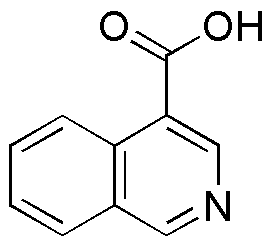Isoquinoline-4-carboxylic acid is widely utilized in research focused on:
- Pharmaceutical Development: This compound serves as a key building block in the synthesis of various pharmaceuticals, particularly those targeting neurological disorders.
- Organic Synthesis: It is commonly used in organic chemistry for creating complex molecules, offering a versatile framework for researchers looking to develop new compounds.
- Biochemical Research: The acid plays a role in studying enzyme activity and metabolic pathways, aiding researchers in understanding biological processes and disease mechanisms.
- Material Science: Its unique properties make it suitable for developing advanced materials, such as polymers and coatings, which can enhance product performance.
- Analytical Chemistry: Isoquinoline-4-carboxylic acid is utilized in various analytical methods, including chromatography, to help identify and quantify other compounds in complex mixtures.
General Information
Properties
Safety and Regulations
Applications
Isoquinoline-4-carboxylic acid is widely utilized in research focused on:
- Pharmaceutical Development: This compound serves as a key building block in the synthesis of various pharmaceuticals, particularly those targeting neurological disorders.
- Organic Synthesis: It is commonly used in organic chemistry for creating complex molecules, offering a versatile framework for researchers looking to develop new compounds.
- Biochemical Research: The acid plays a role in studying enzyme activity and metabolic pathways, aiding researchers in understanding biological processes and disease mechanisms.
- Material Science: Its unique properties make it suitable for developing advanced materials, such as polymers and coatings, which can enhance product performance.
- Analytical Chemistry: Isoquinoline-4-carboxylic acid is utilized in various analytical methods, including chromatography, to help identify and quantify other compounds in complex mixtures.
Documents
Safety Data Sheets (SDS)
The SDS provides comprehensive safety information on handling, storage, and disposal of the product.
Product Specification (PS)
The PS provides a comprehensive breakdown of the product’s properties, including chemical composition, physical state, purity, and storage requirements. It also details acceptable quality ranges and the product's intended applications.
Certificates of Analysis (COA)
Search for Certificates of Analysis (COA) by entering the products Lot Number. Lot and Batch Numbers can be found on a product’s label following the words ‘Lot’ or ‘Batch’.
*Catalog Number
*Lot Number
Certificates Of Origin (COO)
This COO confirms the country where the product was manufactured, and also details the materials and components used in it and whether it is derived from natural, synthetic, or other specific sources. This certificate may be required for customs, trade, and regulatory compliance.
*Catalog Number
*Lot Number
Safety Data Sheets (SDS)
The SDS provides comprehensive safety information on handling, storage, and disposal of the product.
DownloadProduct Specification (PS)
The PS provides a comprehensive breakdown of the product’s properties, including chemical composition, physical state, purity, and storage requirements. It also details acceptable quality ranges and the product's intended applications.
DownloadCertificates of Analysis (COA)
Search for Certificates of Analysis (COA) by entering the products Lot Number. Lot and Batch Numbers can be found on a product’s label following the words ‘Lot’ or ‘Batch’.
*Catalog Number
*Lot Number
Certificates Of Origin (COO)
This COO confirms the country where the product was manufactured, and also details the materials and components used in it and whether it is derived from natural, synthetic, or other specific sources. This certificate may be required for customs, trade, and regulatory compliance.


